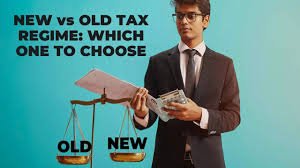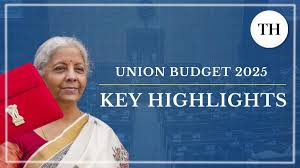ax Regime Comparison – Old vs. New Tax Regime in Budget 2025
Introduction to Budget 2025 Tax Reforms
In Budget 2025, Finance Minister Nirmala Sitharaman introduced significant changes to India’s tax system, focusing on the comparison between the old and new tax regimes. This year, the government has made considerable modifications aimed at simplifying taxation, offering more benefits to the middle-class taxpayers, and enhancing the overall ease of doing business. The focus is primarily on offering better tax incentives while maintaining a balance between fiscal consolidation and taxpayer welfare.
Old Tax Regime vs New Tax Regime – Key Differences
The new tax regime, which was introduced in Budget 2020, comes with lower income tax rates but eliminates most of the exemptions and deductions that were previously available under the old tax regime. These included exemptions like house rent allowance (HRA), standard deduction, and deductions for investments under sections such as 80C. The old tax regime, however, continues to allow these exemptions, which provide taxpayers with more flexibility in reducing their taxable income.
The primary goal of the new tax regime is to simplify the tax structure, making it easier for taxpayers to file returns without complex calculations. However, the old tax regime remains a viable option for taxpayers who prefer to claim exemptions and deductions to lower their taxable income.
Tax Slabs: Old vs. New
In terms of tax slabs, the new regime introduced lower tax rates across various income brackets. For instance, income between Rs 2.5 lakh and Rs 5 lakh is taxed at 5% in the new regime, compared to 20% in the old regime. Similarly, higher-income individuals also benefit from reduced tax rates under the new regime.
However, the old regime maintains higher tax rates but allows deductions. For taxpayers who have significant deductions under sections like 80C, the old regime can be more beneficial.
Simplification for Taxpayers
The shift to a simplified tax structure in the new regime has been appreciated by many taxpayers, especially those who find it cumbersome to manage numerous deductions and exemptions. This change reflects the government’s intention to make taxation simpler, transparent, and less burdensome, particularly for the salaried class.
Implications for Various Taxpayers
The impact of the new regime will depend on individual circumstances. Those with significant deductions (such as investments, home loan interest, or medical insurance) may prefer the old regime, while those without such deductions might find the new regime more advantageous. The tax-saving options under the old regime remain intact, which benefits taxpayers with a higher income who can leverage deductions to minimize their tax liability.
Conclusion
The comparison between the old and new tax regimes in Budget 2025 provides taxpayers with a choice based on their financial planning and goals. The new regime is designed to offer a simpler and more transparent tax structure, whereas the old regime continues to offer flexibility for taxpayers who benefit from deductions and exemptions. With these reforms, taxpayers are now empowered to choose the regime that best fits their needs.

Why this News is Important
Simplification of Taxation
The changes introduced in Budget 2025 are crucial as they seek to simplify the Indian tax system. A simpler tax structure is particularly significant for government exam aspirants, as it highlights the government’s focus on ensuring ease of compliance and reducing tax-related complexities. It also shows the government’s commitment to improving taxpayer experience.
Impact on the Common Man
The introduction of lower tax rates in the new regime will directly impact the middle-class taxpayers. As many exam aspirants belong to this group, understanding these changes can provide insights into economic policies that influence various government decisions and public welfare schemes.
Reflection of Government’s Economic Strategy
This tax revision reflects the Indian government’s broader economic strategy, which is crucial for civil service aspirants. By focusing on tax simplification, the government is addressing the concerns of various stakeholders, ensuring that the tax system evolves with the changing economic landscape.
Implications for Policy Decisions
For students aiming for government positions, understanding such tax reforms is vital for policy analysis questions. The tax changes introduced in Budget 2025 may influence decisions related to social welfare programs, government spending, and economic growth, all of which are key topics in civil services and other government exams.
Enhanced Transparency and Ease of Compliance
The Budget reforms demonstrate the government’s ongoing effort to improve transparency and reduce compliance costs. This has broader implications for the country’s business environment, which is a critical subject for exams related to economic policies, administration, and governance.
Historical Context
Background of the Tax Regimes
The Indian tax regime has undergone several reforms in the past decades, with major milestones being the introduction of the Goods and Services Tax (GST) in 2017 and the new tax regime in Budget 2020. The previous tax systems included exemptions and deductions that complicated the filing process.
In 2020, the government introduced a new simplified tax regime, which eliminated most exemptions but reduced the tax rate for various income groups. This was intended to encourage taxpayers to move to a simpler tax system. However, the old tax regime continued to offer exemptions for taxpayers who preferred a more flexible approach.
Evolution of Tax Policies in India
India’s tax policies have evolved from a highly complex and bureaucratic system to one that now offers more transparency and ease of compliance. This evolution reflects broader economic shifts in India, moving towards greater fiscal consolidation and simpler administrative processes, which are pivotal for ensuring efficient governance.
Impact of Budget 2025
Budget 2025’s modifications to the tax regime reflect the government’s aim to create a balance between simplicity and flexibility. The tax system reforms are in line with the government’s focus on boosting consumer confidence and ensuring tax compliance, while also offering benefits to taxpayers.
Key Takeaways from “Tax Regime Comparison – Old vs. New Tax Regime in Budget 2025”
| S.No. | Key Takeaway |
|---|---|
| 1 | Introduction of new tax regime with lower rates – The new tax regime offers lower income tax rates but removes exemptions and deductions. |
| 2 | Old regime allows more exemptions – The old tax regime allows exemptions like HRA and deductions under section 80C, providing flexibility. |
| 3 | Taxpayer choice between two regimes – Taxpayers can choose between the old and new regimes depending on which offers more financial benefit based on their circumstances. |
| 4 | Simplification for easier compliance – The new tax regime aims to simplify the taxation process, particularly benefiting salaried individuals with no significant exemptions. |
| 5 | Impact on middle-class taxpayers – The new tax regime provides significant relief for middle-class taxpayers, making it more attractive for them to opt for lower rates. |
Important FAQs for Students from this News
1. What are the key differences between the old and new tax regimes introduced in Budget 2025?
The new tax regime introduced in Budget 2025 offers lower tax rates but eliminates most exemptions and deductions. The old tax regime retains exemptions such as House Rent Allowance (HRA) and deductions under sections like 80C.
2. Who should opt for the new tax regime?
Taxpayers without significant exemptions or deductions will find the new tax regime beneficial, as it provides lower tax rates across various income brackets, simplifying tax filing.
3. Can taxpayers choose between the old and new tax regimes?
Yes, taxpayers can opt for either the old tax regime with exemptions or the new tax regime, depending on which offers them greater tax savings based on their income and deductions.
4. How will the new tax regime impact the salaried middle class?
The new tax regime will provide substantial relief to the salaried middle-class individuals as it lowers tax rates, making tax filing easier with fewer deductions and exemptions to manage.
5. Are the changes in Budget 2025 applicable to all income groups?
Yes, the changes impact all income groups, with lower tax rates introduced in the new regime for a wider range of taxpayers. However, individuals with substantial deductions might prefer the old regime for greater benefits.
6. Does the new tax regime remove all exemptions?
Yes, the new tax regime eliminates most exemptions and deductions available under the old regime. However, some exemptions may still apply to specific categories like agriculture income and others.
7. Will taxpayers who opt for the new tax regime be penalized for not using deductions?
No, the new tax regime is designed to be simpler and more transparent, providing benefits to taxpayers who do not wish to deal with complex exemptions or deductions.
Some Important Current Affairs Links


















